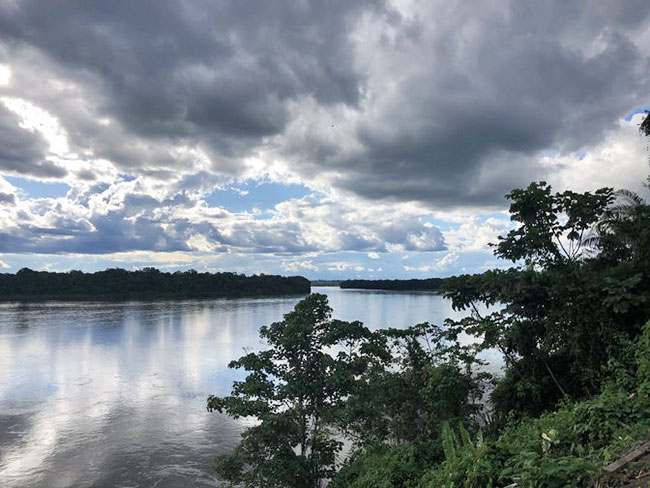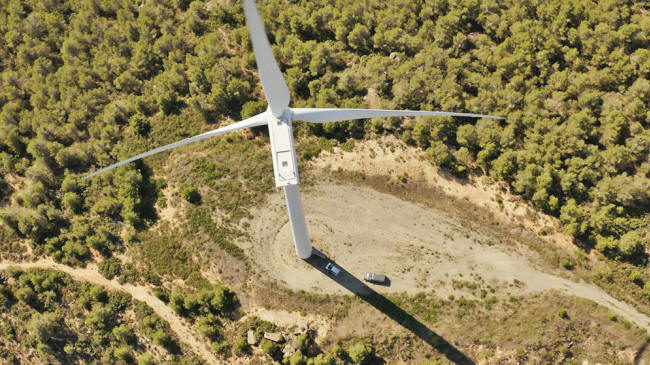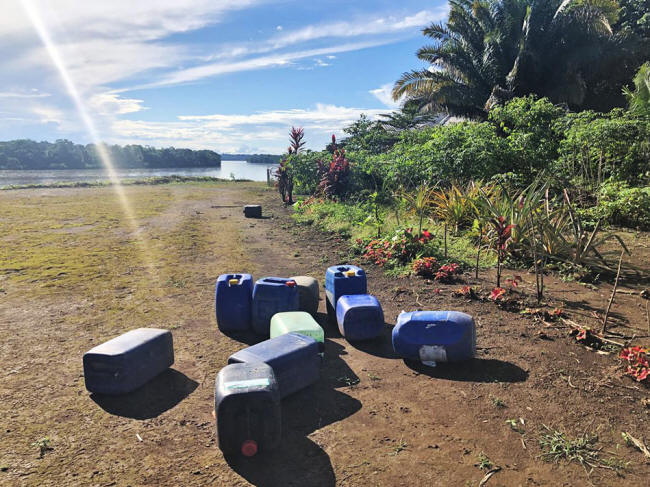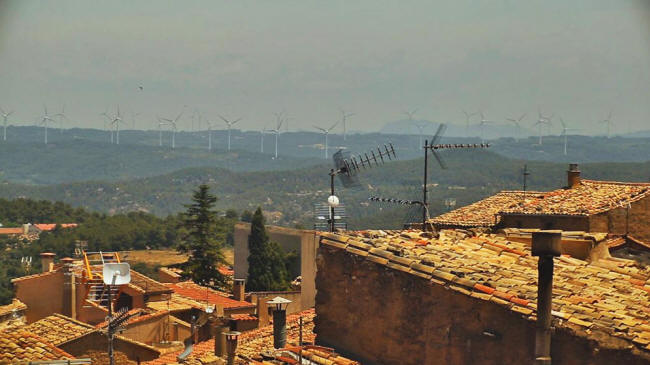|
seen from the community of Sharamentsa
in the
Ecuadorian Amazon a trail of destruction in Ecuador, with a brutal impact on Indigenous communities and fragile ecosystems...
Balsa wood is used in Europe, and also more intensively in China, as a component in the construction of the blades of wind turbines.
Already-installed wind turbines, with blades that stretch to 80 meters, can cover an area of approximately 21,000 square meters, which is equivalent to about three football pitches.
More recent wind turbine designs can incorporate blades that are up to 100-metres long that consume about 150 cubic meters of balsa wood each - equivalent to several tonnes - according to calculations attributed to the National Renewable Energy Laboratory.
In 2018, international demand for balsa wood increased significantly. The tropical wood is flexible and yet hard, while also being both light and resilient.
Ecuador, which is the main exporter of balsa, with about 75% of the global market, is home to several large exporters, such as Plantabal S.A. in Guayaquil, which dedicates up to 10,000 hectares to growing the wood for export.
Balsa fever
The increased demand led to the deforestation of virgin balsa in the Amazon basin, in what came to be known as 'balsa fever'.
Balseros began to illegally deforest virgin balsa from the islands and banks of the Amazonian rivers in an effort to overcome the shortage of cultivated wood.
This has had a terrible impact on the Indigenous peoples of the Ecuadorian Amazon, in a similarly brutal way to that caused by mining and oil extraction in recent decades, and the rubber boom at the start of the 20th century.
In 2019, the extension of a road in the Pastaza province bordering Peru through Indigenous Shuar and Achuar territory to link the community of Copataza to the western city of Puyo, caused controversy among the Achuar people.
For the most part, locals perceived the road, which was built without waiting for full Indigenous consensus, more as a threat of extractivism and deforestation than as a contribution to the potential development of their community.
But it advanced like a syringe through the jungle, reaching its destination in November of that year.
Meanwhile, on the other side of the world, European Commission President Ursula von der Leyen presented the ambitious European Green Pact in Brussels.
The pact, among other things, aimed to reverse climate change by promoting the progressive replacement of fossil fuels, which contribute to global warming through the production of greenhouse gases, with cleaner energy sources.
A wind turbine in a wind farm
in Baix Camp, near Matarraña in Spain
As a result of the 2019 pact, the financial outlook for renewables, including wind power, boosted the number of wind farm construction projects in Europe, and added to China's wind rush.
In December 2020, President Xi Jinping declared that China would increase its installed wind and solar power capacity to more than 1,200 gigawatts (GW) by 2030, a five-fold increase from the current 243GW.
The triggering of 'balsa fever' has had devastating consequences for Ecuador's Indigenous Amazonian communities.
The story soon moved from the local media to the international press.
And in January this year, The Economist published an article pointing out the problems that the irregular extraction of balsa for wind turbine blades had caused in Ecuador, highlighting the negative impact on the Waorani Indigenous people, based within the Yasuní National Park.
In September, when democraciaAbierta visited the Achuar indigenous territory, travelling down the Pastaza River, one of the areas most affected by balsa fever, we found that the territory's balsa had already been completely deforested and that the balseros, in their determination to obtain more wood, had moved onto the Peruvian Amazon.
Rising prices due to supply shortages created an incentive to accelerate search for less environmentally damaging materials...
The consequences of this rush have been especially destructive for local communities.
In June, the Indigenous leaders of the Achuar Nationality of Ecuador (NAE), reacted by declaring that they would not allow the deforestation of balsa wood in their territory.
But it was a futile declaration, which came too late.
In the Sharamentsa community, for example, which has embraced energy innovation by hosting a solar-powered canoe project, and which had actively resisted opening its islands to loggers, one of its leaders finally bowed to pressure - agreeing to the selling of the community's balsa.
It's a decision that has caused pain, rejection and division among families and has had consequences for the ecosystem of the islands and for the river itself.
The balseros bring alcohol, drugs and prostitution, and pollute the extraction sites with plastics, cans, machinery, gasoline and oil spills. They abandon used chains from their chainsaws.
They eat the turtles and chase away the parrots, toucans and other birds that feed on the flowers of the balsa trees.
The breakdown of ecosystems by illegal deforestation has profound impacts on the balance of local flora and fauna, which will never recover.
Given the devastating social and ecological impacts of using balsa wood for wind power, it is urgent that the global turbine industry implements strict measures to trace the origin of the balsa wood it uses, to stop the large-scale reliance on this precious natural resource, and to prevent market pressure from leading to unplanned and illegal deforestation.
Fuel containers lie on the landing strip of the community of Sharamentsa,
Pastaza, Ecuador
Alternatives that are less socially and environmentally damaging need to be relied on instead. Rising prices that followed supply shortages have created a powerful incentive to accelerate this process.
According to The Economist, the price of balsa doubled from mid-2019 to mid-2020.
In fact, alternative materials have been incorporated into the initial production stage of the blades since at least 2014, and have gone into full production after significant supply problems occurred in 2020, including materials such as Polyethylene Terephthalate (PET), a low-density foam generated from plastic bottles.
Consultancy firm Wood Mackenzie has forecast that the proportion of PET use,
Some of the biggest wind turbine producers are already abandoning the use of balsa wood.
Vestas, a world leader in the sector, told openDemocracy it had "significantly reduced" its usage of balsa, instead utilizing alternative materials.
It said that only two of its turbine variants still have blades that use balsa.
For those two models that still use balsa, the wood,
An added problem for the blades is their recyclability.
The first generation of wind turbines are starting to reach the end of their lifespan, meaning approximately 14,000 wind blades will be dismantled in Europe by 2023, according to Ramón González-Drigo, professor in strength of materials and structural engineering at the Polytechnic University of Catalonia in Spain.
For all these reasons, the change of technology is urgent, although the damage to communities and the ecosystem has already been done.
Pressure on rural populations
The socio-environmental impact of wind farms does not end with the issue of massive deforestation of Amazonian balsa.
Many of the regions in Europe that host these wind farms are experiencing serious socio-economic and environmental disruption from ever-larger wind turbines.
Wind farms require constant wind conditions in relatively unpopulated territories, where opposition from local populations is weak.
This is the case of the Matarraña region, in the Spanish province of Teruel, where several wind farm projects are already in the final appeals phase and are very likely to be installed soon.
Many among the local population feel powerless to prevent the arrival of these million-euro investments that cause dire impacts on fauna, flora, landscape and social cohesion.
View of a Baix Camp wind farm from the town of Calaceite
in the Matarraña region, Spain
Wind power contributed 21.9% of the electricity consumed in Spain last year.
The pressure to increase its share in the energy mix is fed by the commitment to decarbonization and the upward pressure on electricity prices, which have soared to levels never seen before in Europe.
This pressure is felt by Spanish communities near wind farms, which perceive wind power companies "as a very strong aggression", according to Esperanza Miravete, a geography and history teacher from Valjunquera, a town of 338 inhabitants in the same region of Matarraña.
Wind energy has already become a key aspect of global strategy and is set for further expansion in the coming years.
But there are downsides to this boom. The deforestation pressure on balsa has been brutal for the Amazonian Indigenous people of Ecuador, while the pressure on regions in Europe to host new wind farms brings with it conflict.
This has created a green paradox.
However, this form of renewable energy will not be ethical or sustainable until every component involved is guaranteed not to cause further harm to the planet and its people...
|





